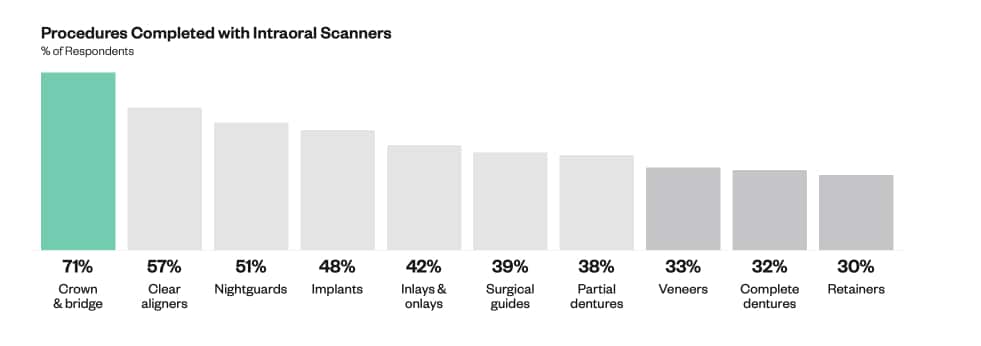Growth in the US dental industry is expected to double in the next five years to over $30 Billion. Several factors contribute to this prediction: an aging population, the growing popularity of cosmetic procedures, and – a topic near and dear to our hearts – advances in dental technology. What trends in dentistry will this bring?
As we found in a recent survey of dental practitioners across the US, there are challenges to reaching this growth. Staffing, for example, is exponentially more difficult than before the COVID-19 pandemic. An American Dental Association (ADA) survey found that 75% of solo dentist practices who are hiring said recruiting dental hygienists is now “extremely challenging” compared to before the pandemic.
Despite the challenges, there are some positive trends that we uncovered in the 2022 Dental Industry Report from Dandy. You’ll find out what services are expected to grow, how dentists are thinking and feeling about digital dentistry in 2022, practice priorities, and more.
This piece will explore five dental industry trends and tips on how you can take advantage of them in your practice to reduce cost, increase profits, and improve the patient experience.
5 Dental Industry Trends to Watch in 2022
1. Orthodontia and endodontia treatments are forecasted to grow at least 5%
Cosmetic dental work is growing in popularity. This is generally attributed to the rise of Zoom meetings and social media influencers. Perhaps that’s part of the reason the global clear aligners market, an orthodontic service, is expected to reach $17 Billion at a robust 27% compound annual growth rate (CAGR) over the next 6 years.
The pandemic also raised the need for healthcare around stress-related dental conditions like teeth grinding, which calls for treatments like clear aligners, retainers, or mouth guards – some of the other services expected to grow.
According to research Dandy conducted in 2021, top dental treatments forecasted to grow in-house are specialty services such as orthodontia and endodontia. Findings revealed that dentists expect growth of at least 5% over the next 3-5 years in:
- Clear aligners
- Implants placed
- Implants restored
- Zirconia crown & bridge
- Nightguards
- eMax crown & bridge
How to take advantage of this trend: Finding cost-effective ways to increase specialty service offerings is imperative if practices want to take advantage of this growing trend. Reduce chair time and turnaround time, and you’ll be able to serve more patients and offer more in-house services. Digital technology like an intraoral scanner and a digital dental lab make that possible.
2. Increasing practice profitability is priority number one in 2022
On the surface, this one hardly sounds like a trend. After all, isn’t profitability always a priority? Maybe so, but this year’s survey shows that the #1 priority of 65% of dentists directly corresponds to the top challenge entering 2022: rising costs.
With inflation reaching 7% in 2021, coupled with the continuous challenges facing the supply chain and labor shortage, it’s not a surprise that 66% of dentists reported rising costs as their number one challenge.

As practitioners look to overcome these challenges, practice growth is top of mind. We see this indicated in the desire to increase profitability and their number two and three priorities: increasing production and adding new patients to increase the total number of patients.
How to take advantage of this trend: It can be reassuring to know that every practice is feeling the squeeze from a tighter budget. Rising costs will force practices to become more resourceful and expand beyond their comfort level to improve efficiency. Look for solutions that reduce chair time, eliminate the need for multiple restoration redos, decrease supply costs, and can be done by multiple employees within a practice.
3. By 2023, up to 75% of dentists will use an intraoral scanner
The results are clear: digital dentistry is on its way to becoming the standard. 50% of dentists surveyed already use an intraoral scanner for digital impressions. And those who aren’t? 51% say they plan to begin using one in 2022. That’s roughly 75% of dentists we surveyed who said they are – or plan to begin – using an intraoral scanner this year.
There are many reasons why dentists are going digital with intraoral scanners, digital workflows, and labs that accept digital scans.
- Faster, more accurate impressions
Dr. Michael Clay, owner of Gulf Coast Dental, says, “I know what [restorations] are going to look like before I get them, and they work every time. No remakes and I think I’ve had to touch up a crown maybe five times in the last five months. That’s extraordinary.” - Increased productivity
Scanning is easy. Anyone trained can do it, leaving dentists free to perform higher-value procedures. Fewer redos on impressions and adjustments or remakes open more time for other patients and treatments. - Cost savings
The shift to digital impressions eliminates the need for impression materials and shipping fees to the lab. And the decrease in redos and remakes saves teams from the endless phone tag involved in rescheduling. - Higher perceived value
Patients appreciate and are willing to pay for new technologies that deliver a great experience. Dental offices that use digital technology are perceived as ‘high end’. - Greater case acceptance
Showing patients exactly what’s going on in their mouths makes it easier to convince them to move ahead with treatment. Dr. Kevin To, owner of OnCall Urgent Dental Care, chalks this up to ‘seeing is believing.’ He says, “…it gets people excited. It helps them actually reinvest in their own health.” - Improved patient experience
Faster, less gag-inducing impressions is a win-win for doctors and patients. And as Dr. Angela Leung, owner of The Endodontics Implant Center, says, there’s a ‘wow-factor’ when patients see their scans in real-time.
“When patients see the scanner, and they turn around and see the images almost instantaneously, in nice colors, every patient is impressed.”
– Dr. Angela Leung, The Endodontics Implant Center
How to take advantage of this trend: Go digital! It’s easier than ever to begin using digital tools and workflows in your practice. Another key component is the lab you work with. Does your lab accept digital scans? What’s their level of experience with digital dental technology? Consider working with a full-service digital-only dental lab like Dandy to benefit from a seamless experience from scanning to submitting to fitting.
Related
- The 4 Criteria to Consider When Choosing an Intraoral Scanner
- The Top 5 Benefits of a Digital Workflow for Dentistry According To Real Dentists
- What is Digital Dentistry?
4. Dental practices that prioritize patient experience are 2x more likely to use an intraoral scanner
Let’s be clear – patients today are absolutely influenced by their digital consumer experience. And in the last two years, everyone, across generations, has been living online. Patients are bringing their expectations for extreme convenience and excellent customer experience from the digital world into the real world. And what they want from healthcare providers is a seamless, efficient, and timely experience.
We believe this is part of why dentists surveyed who prioritize patient experience are twice as likely to use an intraoral scanner.
It’s also impossible to ignore the fact that taking impressions with an intraoral scanner is faster and much more comfortable than traditional impressions. Add to that the distinct lack of redos and extremely minimal adjustments needed to final restorations, and it’s no wonder that 67% of dentists who prioritize patient experience use an intraoral scanner. It just makes the patient experience more comfortable. Happier patients = higher return rate and more referrals.

How to take advantage of this trend: More and more practices are finding innovative ways to improve the patient experience. For practices to stay competitive, they must adopt new technology for patient-facing scenarios.
While digital dental technology can help with practice management and overall efficiency, the improvements to the customer experience can’t be overlooked. As Dr. Angela Leung put it, “when patients see the scanner, and they turn around and see the images almost instantaneously, in nice colors, every patient is impressed. It’s the ‘wow’ factor – and when they have the wow factor, they refer more patients to our practice.”
5. Dentists underutilize digital scanning for retainers, dentures, and veneers
Crown and bridge restorations are, by far, the procedures most commonly completed using an intraoral scanner, at 71% of total procedures completed. It makes sense; 90% of dental practitioners perform this common dental procedure.
Exploding in popularity recently are clear aligners, and 57% of the dentists we surveyed who use an intraoral scanner use it for aligners, with nightguards right behind at 51%.
But for several full-mouth procedures where patients could benefit from digital impressions, most dentists still aren’t using intraoral scanners. For partial dentures (38%), veneers (33%), full dentures (32%), and retainers (30%), patients are often stuck with traditional, unpleasant PVS impressions – and dentists are stuck with all of the drawbacks inherent to them.

Although the verdict is still out on exactly why not all dentists are utilizing intraoral scanning for these procedures, anecdotal evidence suggests that lab partners’ inability to accept digital scan files for these products plays a role for many dentists.
How to take advantage of this trend: If you’re using an intraoral scanner in your practice, you’re already experiencing the benefits of digital dentures, crowns, veneers, and aligner impressions. Why not look to add more digital workflows? Make sure your lab is experienced with these digital scans and find a digital dental partner that makes it easy to adopt new workflows.
2022 Dental Industry Trends Summary: It’s Time to Go Digital
For dental practice growth in the coming years, it’s time to go digital. Patients expect convenience and a comfortable experience. Adding specialty services like clear aligners, shifting to digital impressions with an intraoral scanner for all procedures, and prioritizing patient experience by using the latest technology allow practitioners to keep up with the patient consumers’ demands – and find success in 2022 and beyond.
Read Dandy’s 2022 Dental Industry Report to learn more about the trends discussed in this article, along with what dentists had to say about dental labs, practice management software (PMS), and more.


